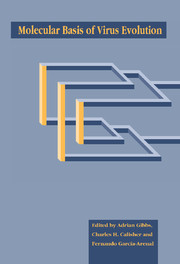Book contents
- Frontmatter
- Contents
- List of contributors
- Editors' preface
- Conference participants
- 1 Introduction and guide
- Part I The impact of viral diseases
- Part II Origins of viruses and their genes
- Part III Sources of virus variation
- 8 Molecular mechanisms of point mutations in RNA viruses
- 9 Recombination and its evolutionary effect on viruses with RNA genomes
- Part IV Molecular interactions of viruses and their hosts
- Part V Viruses, hosts and populations
- Part VI Case studies of viral taxa; their systematics and evolution
- Part VII Techniques for viral systematics
- Index
9 - Recombination and its evolutionary effect on viruses with RNA genomes
Published online by Cambridge University Press: 04 May 2010
- Frontmatter
- Contents
- List of contributors
- Editors' preface
- Conference participants
- 1 Introduction and guide
- Part I The impact of viral diseases
- Part II Origins of viruses and their genes
- Part III Sources of virus variation
- 8 Molecular mechanisms of point mutations in RNA viruses
- 9 Recombination and its evolutionary effect on viruses with RNA genomes
- Part IV Molecular interactions of viruses and their hosts
- Part V Viruses, hosts and populations
- Part VI Case studies of viral taxa; their systematics and evolution
- Part VII Techniques for viral systematics
- Index
Summary
Sequence mutation is the most common mechanism for the evolution of RNA viruses. However, major changes of viral genotype often involve exchanges of RNA segments between viruses, as exemplified by influenza virus evolution. For viruses with non-segmented RNA genomes, genetic exchange was previously thought to be rare. In recent years, however, sequence analyses of viral RNA revealed that many RNA viruses have apparently evolved from other viruses by exchange or rearrangement of genome sequences. Furthermore, experimental systems have been established for several viruses, in which recombination could be demonstrated between two viral RNAs. Thus, genetic recombination appears to be more important in RNA virus evolution than was previously realized.
Mechanistically, RNA recombination is similar to the generation of defective-interfering (DI) RNA, as both involve polymerase jumping during RNA synthesis. Many RNA viruses generate DI RNA and, thus, can potentially undergo genetic recombination. However, recombination has not been commonly observed. Therefore, there may be genetic restriction on RNA recombination or selective disadvantage for recombinant viruses.
RNA recombination in experimental systems with animal viruses
Evidence for RNA recombination was first obtained in classical genetic studies involving polioviruses (family Picornaviridae). When cells were co-infected with virus resistant to the antibodies in horse or cattle serum and virus resistant to guanidine, viruses resistant to both antibody and guanidine could be isolated at a higher frequency than by spontaneous mutation, suggesting that recombination may have occurred (Hirst, 1962; Ledinko, 1963). Similar observations were made on foot-andmouth disease virus (FMDV) (Pringle, 1965).
- Type
- Chapter
- Information
- Molecular Basis of Virus Evolution , pp. 119 - 132Publisher: Cambridge University PressPrint publication year: 1995
- 10
- Cited by



